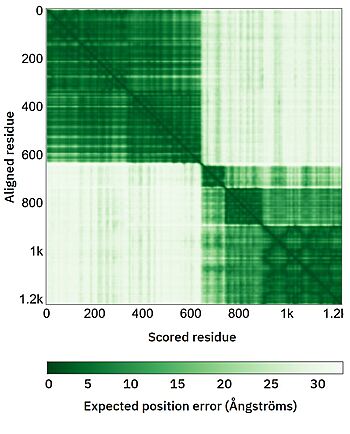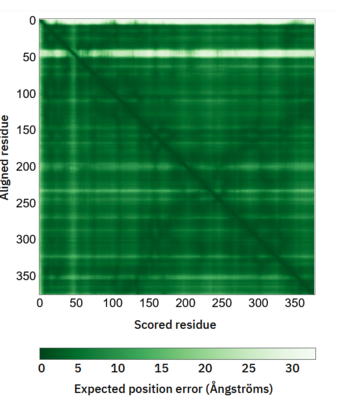pLDDT
The pLDDT value (reload ) is assigned to each individual residue and stored in coordinate files instead of temperature factors. Different from temperature factors, high values indicate high confidence in atomic positions, and low values low confidence (scale of 0 to 100). This value is named pLDDT because it predicts the so-called LDDT value (Local Distance Difference Test, [1]), a way to characterize the difference of two related conformations without aligning the structures.
Expected distance error
Alphafold also predicts the expected error in the distance of two residues. Thus, this is a 2-dimensional (pairwise) data set. The plot of the data is shown below. On the right, you can see the mapped by color on the second residue. If you hover over the residue, it will show the estimated distance error. It becomes apparent that the distance between residue 1000 and residues in the N-terminal part of the protein are ill-defined. However, if you show the expected errors to residue 400 (by using the links below), the N-terminal domain is well-defined in isolation. It is the relative domain orientation that is not well predicted. If you explore some other of the residues provided below, you will discover that there are subdomains within the N-terminal as well as the C-terminal domain. This is experimentally supported, e.g. for the cap subdomain (click on 680 below) that plays a role in protecting B12 from unwanted redox reactions.
Residue

Residues near the apparent domain interface
Some residues that are highlighted in the are near the apparent domain interface. This might be because they have spatial neighbors in a different domain whose relative orientation is ill-defined. Thus, it would be a misinterpretation to conclude that these residues are disordered with respect to their own domain. The LDDT algorithm was choosen to suppress these inter-domain signals (by choosing a small radius of neighbors considered), but there does seem to be some overlap of intra-domain disorder and inter-domain orientation within the pLDDT measure.
Medium Distance Difference Test
The LDDT was designed to measure model consistency (or confidence) within a domain. To create a measure of inter-domain confidence, this is an alternate algorithm. 1) For each residue, find other residues with a center-of-mass distance of between 10 and 15 Angstroms. 2) Take the 10 worst distance differences (or estimates) and average them. Calculating this measure for the structure prediction of methionine synthase gives an . For this structure, about 40 neighbors were found on average at the chosen distance cutoff. While the problems in the interface between the N-terminal and C-terminal part are already hinted at in the pIDDT measure, this analysis also nicely shows that the B12 binding domain might switch neighbors as it approaches the three other substrate binding sites in the enzyme.
Other examples of model uncertainty
The prediction of the UvrB structure [1] shows some off-diagonal elements in the 2D distance uncertainty plot. This is because domains are not consecutive in the sequence; instead, along the sequence, domain 1 is "interrupted" by domain 2 (spanning residues 150-250, approximately). In addition, the very C-terminal part of the protein is structured but attached to the remainder of the protein by just a flexible tether. These features are apparent in the 2D distance plot, but it would be nice to visualize them by mapping them on the 3D structure.

The prediction of the bovine actin structure shows high certainty of most elements, and no indication of domain movements. Instead, there is one loop that has low scores in the 1D and 2D certainty data. In this simpler case, mapping the 1D certainty data on the 3D structure gives sufficient information.




